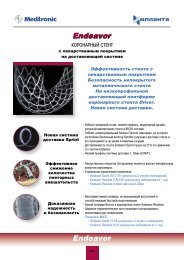Results of Coronary Stenting using the Stents with
Results of Coronary Stenting using the Stents with
Results of Coronary Stenting using the Stents with
Create successful ePaper yourself
Turn your PDF publications into a flip-book with our unique Google optimized e-Paper software.
Interventional angiology<br />
Significance <strong>of</strong> Anatomical Variability <strong>of</strong> Tibial and Foot<br />
Arteries for Peripheral Angioplasty in Patients <strong>with</strong><br />
Critical Ischemia<br />
D.V. Ovcharenko 1 , M.Yu. Kapytin, A.A. Voronkov, S.A. Platonov.<br />
Department <strong>of</strong> endovascular diagnostics and treatment, Djanelidze Research Institute <strong>of</strong> Emergency Medicine,<br />
St. Petersburg, Russia<br />
The authors present a retrospective evaluation <strong>of</strong> <strong>the</strong> incidence <strong>of</strong> atypical anatomical variants <strong>of</strong> tibial arteries<br />
origin and foot blood supply associated <strong>with</strong> critical ischemia, treated by peripheral angioplasty. Intraprocedural<br />
complications caused by atypical anatomy have been taken into consideration.<br />
Keywords: peripheral angioplasty, critical lower limb ischemia, popliteal artery, anterior tibial artery, posterior<br />
tibial artery.<br />
Purpose <strong>of</strong> study. This study was aimed at <strong>the</strong><br />
evaluation <strong>of</strong> <strong>the</strong> significance <strong>of</strong> atypical anatomical<br />
variants <strong>of</strong> popliteal artery branching and foot arteries<br />
origin for <strong>the</strong> performance <strong>of</strong> peripheral angioplasty<br />
in patients <strong>with</strong> critical lower limb ischemia (CLLI), in<br />
whom angioplasty has been used as a primary revascularization<br />
method.<br />
Material and methods. In total, 248 peripheral<br />
angioplasties (PAP) have been performed in 240 patients<br />
<strong>with</strong> CLLI. The incidence <strong>of</strong> atypical anatomical<br />
variants <strong>of</strong> popliteal artery branching and foot arteries<br />
origin has been studied retrospectively. Clinical<br />
results and complications <strong>of</strong> peripheral angioplasty<br />
in patients <strong>with</strong> typical and atypical branching <strong>of</strong> <strong>the</strong><br />
popliteal artery and foot blood supply have been<br />
studied.<br />
<strong>Results</strong>. Atypical branching <strong>of</strong> <strong>the</strong> popliteal<br />
artery and foot blood supply have been noted in<br />
31 (12,5%) cases (out <strong>of</strong> 248 legs, on which PAP<br />
was performed). Aplasia — hypoplasia <strong>of</strong> <strong>the</strong> tibial<br />
branches <strong>with</strong> dorsalis pedis artery (DPA) and/<br />
or plantar artery (PlA) arising from <strong>the</strong> peroneal<br />
artery was seen in 17 cases (6,8% <strong>of</strong> 248 legs, in<br />
which PAP has been performed). Here<strong>with</strong> only 14<br />
(45%) cases (out <strong>of</strong> 31 <strong>with</strong> atypical anatomy) were<br />
revealed during diagnostics. In seven (41%) <strong>of</strong> <strong>the</strong><br />
remaining 17 cases (non-recognizable before PAP)<br />
<strong>the</strong> peculiarities were suspected only after <strong>the</strong> occurrence<br />
<strong>of</strong> complications. There were no significant<br />
differences between legs preservation rate in<br />
<strong>the</strong> groups <strong>with</strong> typical and atypical anatomy.<br />
Conclusion. Atypical variants <strong>of</strong> lower leg and<br />
foot blood supply are ra<strong>the</strong>r frequent and if not timely<br />
recognized can cause specific complications.<br />
1<br />
Address for correspondence:<br />
Dr. Dmitry Ovcharenko<br />
Russia, 192242, St. Petersburg, ul. Budapeshskaya, 3<br />
Tel. 007 812 313-46-38<br />
Cell. 007 911-915-93-88<br />
факс. (812) 313-46-46<br />
E-mail: dovcharenko@rambler.ru<br />
Manuscript received on May 13, 2011.<br />
Accepted for publication on July 14, 2011.<br />
List <strong>of</strong> abbreviations<br />
CLLI — critical lower limb ischemia<br />
PAP — peripheral angioplasty<br />
PA — popliteal artery<br />
ATA — anterior tibial artery<br />
PTA — posterior tibial artery<br />
PeA — peroneal artery<br />
DPA — dorsalis pedis artery<br />
PlA — plantar artery<br />
TPT — tibioperoneal trunc<br />
Introduction<br />
Endovascular interventions are playing an increasing<br />
role in <strong>the</strong> treatment <strong>of</strong> critical lower ilmb<br />
ischemia (CLLI), expecially in diabetics. In order to<br />
achieve clinical success it is necessary to restore antegrade<br />
blood flow into <strong>the</strong> arterial arch <strong>of</strong> <strong>the</strong> foot. It<br />
<strong>of</strong>ten requires recanalization <strong>of</strong> extended occlusions<br />
<strong>of</strong> <strong>the</strong> tibial and foot arteries, being <strong>the</strong> predominant<br />
form <strong>of</strong> arterial lesions in such patients (1, 2).<br />
Besides typical branching <strong>of</strong> <strong>the</strong> popliteal artery<br />
(PA) below <strong>the</strong> cleft <strong>of</strong> <strong>the</strong> knee into <strong>the</strong> anterior<br />
tibial artery (ATA) and tibioperoneal trunk (TBT)<br />
prolonged by <strong>the</strong> posterior tibial artery (PTA), <strong>the</strong>re<br />
are o<strong>the</strong>r anatomical variants. They are caused by<br />
embryological development and <strong>the</strong>ir incidence<br />
varies from 7,4% to 17,6% (3, 4). Basing on <strong>the</strong> results<br />
<strong>of</strong> 1000 legs’ angiography, Kim et al. (3) suggested<br />
a practical classification <strong>of</strong> anatomical variants<br />
<strong>of</strong> branching, being a modification <strong>of</strong> Lippert<br />
и Pabst classification (5). The authors suggested<br />
three types <strong>of</strong> anatomical variants that account for<br />
<strong>the</strong> level and <strong>the</strong> character <strong>of</strong> branching <strong>of</strong> <strong>the</strong> popliteal<br />
artery, as well as <strong>the</strong> origin <strong>of</strong> <strong>the</strong> foot arteries.<br />
Type I includes <strong>the</strong> variants <strong>with</strong> normal level<br />
<strong>of</strong> PA branching, where typical anatomical variant<br />
is denominated as IA. Type II comprises <strong>the</strong> cases<br />
<strong>with</strong> high level <strong>of</strong> popliteal artery branching above<br />
<strong>the</strong> cleft <strong>of</strong> <strong>the</strong> knee, and type III — <strong>the</strong> cases <strong>with</strong><br />
aplasia or hypoplasia <strong>of</strong> <strong>the</strong> tibial branches <strong>with</strong><br />
dorsalis pedis artery and/or plantar artery arising<br />
from <strong>the</strong> peroneal artery (Fig.1).<br />
42<br />
(№ 26, 2011)
















